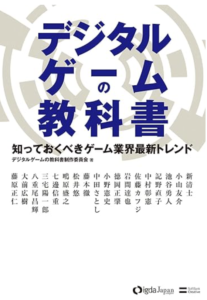Basic technology for digital game AI (time-based recognition technology)
Continuing from the previous article, I will discuss digital game AI technology. In this article, we will discuss time-based recognition technology.

Textbook of Digital Games: The Latest Trends in the Game Industry You Need to Know
In digital games, it is very important to view the AI from the perspective of time. In order for an AI to be able to recognize the time axis, it must first be given a past (memory), and in order to give it a memory, it is necessary to secure a storage area (memory) and determine the format of the memory.
For example, in the game F.E.A.R., memory is formed for the objects and targets in the stage using a common knowledge format of “location, direction, stimulus, desire, time of information acquisition, and information reliability as seen by the AI. Using this memory, the AI extracts information and uses it for decision making; Dumcan keeps a time-stamped memory of the same object. Dumcan keeps a time-stamped memory of the same object, and uses this time-series memory to predict when the ball seen behind the wall will appear from behind the wall.
Next, there are various approaches to the means of giving AI a sense of the future. The most commonly used of these is “Goal-oriented (Goal-based) Planning”. Goal-oriented is a behavioral principle of AI, where the goal is determined first and then actions are designed to achieve the goal. While reflexive AI reacts to the current environment, goal-oriented AI first designs a goal in the future and then takes action. When there is more than one of these goals, it uses a decision-making algorithm to determine which goal to carry out before acting on it.
This goal-oriented planning has been used in simulation games since the 90’s. In simulation games, when there is a process of “production”, C to B and B to A are made in order according to the arrangement that “B is needed to make A and C is needed to make B”. In simulation games, these production arrangements are given in the form of tree-like data, and the AI carries out production activities accordingly (e.g., age of empire). In this means, the planning is only statically executed.
In contrast, there has been work since the mid-2000s to incorporate planning into an AI that acts in real time, like an enemy in a FPS. (e.g., F.E.A.R.) This uses a method called “chain planning,” in which actions are described in advance based on three elements: “preconditions (for the action),” “action,” and “result of the action,” and then the “preconditions” are connected to the “result” among multiple actions. (Goal Oriented Action Planning : GOAP)
In chain planning, in order to connect elements of the same dimension, there is a secret Ise role in matching each condition. In contrast, “Hierarchical Planning” was proposed to deal with more difficult problems in reality. In this method, a goal is broken down into several medium goals, and then the medium goals are broken down into small goals, and the goals are accomplished in order to finally achieve the original goal.
In this hierarchical planning, goals are not simply decomposed statically, but are dynamically decomposed into the next level of goals (stacked) according to the situation when the goal becomes active. The goals on the stack are activated and executed in order, but the activated goal is decomposed to the next level according to the situation at that time when it becomes active.

デジタルゲームの教科書より
The “time-scale hierarchical technology” is a combination of the technologies described so far. This is a combination of “reflective AI” and “planning AI,” where the reflective AI is used for areas that require immediate response in a narrow domain, and the planning AI is used for areas that require thinking over a long span of time. Basically, a plan is created for each time scale, and on a case-by-case basis, an algorithm is used that prioritizes the smallest time scale.
Another method of “time-scale hierarchical technology” is the subsumption method. For example, “turn if there is a response to the sensor” is the first layer, “proceed if there is no response” is the second layer, and “wander” and “avoid” are the advanced behaviors using these functions. For example, the first layer is to “turn if there is a reaction to the sensor” and “proceed if there is none”, the second layer is to “wander” and “avoid”, and the third layer is to create “path planning” and “investigating” using these functions.


コメント